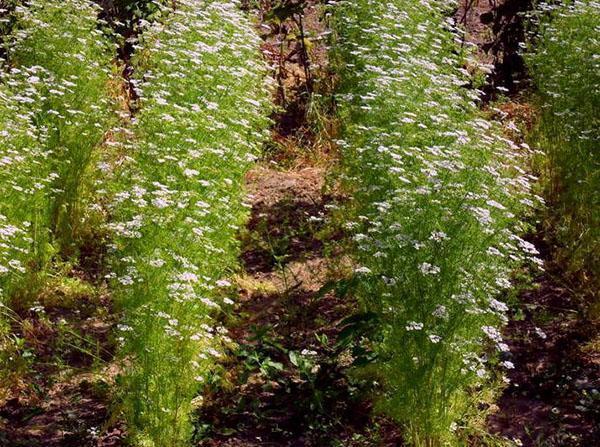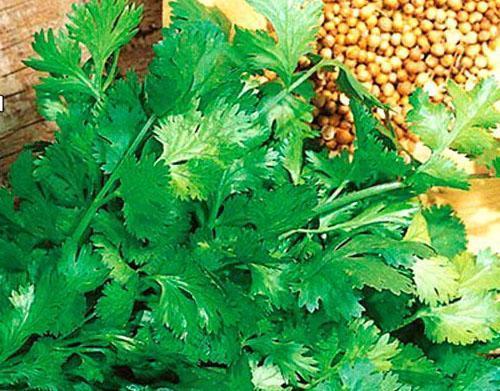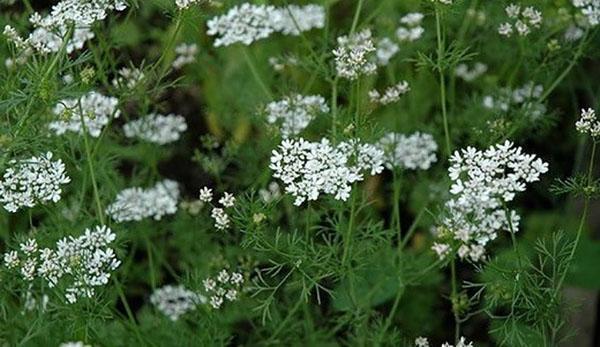Growing coriander from seeds is a simple matter for taste and health
 Fresh herbs on the table are taste, pleasure and benefit. Growing coriander from seeds does not take much time and effort. This spicy herb will diversify the daily diet, add spicy notes and a unique aroma to dishes. The culture is available for cultivation in the open field, in a greenhouse and at home - in a pot. She needs a minimum of attention and care. Green seasoning is used directly from the garden - fresh and harvested for future use - dried, crushed and stored. The seeds are used for further propagation and as food - as a spice.
Fresh herbs on the table are taste, pleasure and benefit. Growing coriander from seeds does not take much time and effort. This spicy herb will diversify the daily diet, add spicy notes and a unique aroma to dishes. The culture is available for cultivation in the open field, in a greenhouse and at home - in a pot. She needs a minimum of attention and care. Green seasoning is used directly from the garden - fresh and harvested for future use - dried, crushed and stored. The seeds are used for further propagation and as food - as a spice.
Coriander culture - description and properties

Another name for coriander is cilantro, this delicious herb is endowed with many health benefits. It has a pleasant smell and original taste, it contains essential oils, fiber and vitamins. Coriander improves appetite and well-being, heals and prolongs life!
 Coriander belongs to herbaceous annuals of the umbrella family. The fragrant herb reaches a height of 30 to 50 cm and has two types of leaves - simple and pinnately dissected. Flowering begins 3 months after sowing, white or pinkish flowers form seed umbrellas by mid-summer. Seed ripening ends by mid-September.
Coriander belongs to herbaceous annuals of the umbrella family. The fragrant herb reaches a height of 30 to 50 cm and has two types of leaves - simple and pinnately dissected. Flowering begins 3 months after sowing, white or pinkish flowers form seed umbrellas by mid-summer. Seed ripening ends by mid-September.
Sowing and growing herbs
Coriander or cilantro is a long-day grass, so it is planted in an open part of the garden, where there is a lot of air and light. The abundance of shade slows down the growth of the plant and significantly weakens it. The stem of coriander is straight and branched, the upper leaves are elongated and attached directly to it. The lower leaves have petioles, with which they are fixed on the stem. Flowers are collected in umbrellas that end the stem of the plant.
How to plant coriander:
- Season. Coriander is sown in late spring - from late April to early May. Frosts are unfavorable for him, he does not tolerate heat well.
- The soil. Airy and fertile soil is an ideal base for culture. In order to improve the soil, you can mix it with sand, add a little humus and wood ash.
- Site preparation. The best place to grow spicy herbs is in sunny or semi-shaded areas. The grass doesn't like too much shade.
- Landing. Sowing of coriander is carried out in wet soil in random or rows. There should be 10 to 15 cm between the seeds, the row spacing should be about 25-30 cm, and the optimal sowing depth should be up to 2 cm.
 The yield of coriander depends on the germination and quality of the seeds, the fertility and moisture of the soil, weed infestation and the amount of daylight. It is better to remove excess sprouts, as the grass grows in rosettes, and neighboring plants can interfere with each other.
The yield of coriander depends on the germination and quality of the seeds, the fertility and moisture of the soil, weed infestation and the amount of daylight. It is better to remove excess sprouts, as the grass grows in rosettes, and neighboring plants can interfere with each other.
Catering for dining culture
 Planting and caring for coriander outdoors is to prevent overgrowth. The first shoots are thinned out, leaving stronger and more hardy plants.Young shoots that have reached a height of 10-15 cm are used for food, old branches can be bitter. The coriander beds are watered as needed, free of weeds and loosened up the soil. In the fight against weeds, root mulching helps. Mineral dressing applied before planting, during the growth process, you can fertilize the coriander beds with potassium and superphosphate.
Planting and caring for coriander outdoors is to prevent overgrowth. The first shoots are thinned out, leaving stronger and more hardy plants.Young shoots that have reached a height of 10-15 cm are used for food, old branches can be bitter. The coriander beds are watered as needed, free of weeds and loosened up the soil. In the fight against weeds, root mulching helps. Mineral dressing applied before planting, during the growth process, you can fertilize the coriander beds with potassium and superphosphate.
To be provided with coriander greens throughout the summer, it is necessary to plant the crop in batches - every 2-3 weeks.
When to plant coriander outdoors:
- from the third decade of March to the second decade of May;
- throughout the summer season at intervals of several weeks.
Cilantro is an unpretentious and cold-resistant plant, loves a sufficient amount of moisture and sun. The first shoots appear 28-40 days after planting. During a set of green mass, the grass needs systematic watering - twice a week. Coriander is a dry climate culture, so excess moisture affects it negatively.
Harvesting and harvesting
 If you cut more than a third of the plant at a time, it will no longer grow. To ensure the growth and development of the plant in two or three cycles in a row, it is necessary to remove only the upper leaves, leaving the lower shoots. In the process of flowering, the grass ceases to produce shoots suitable for food. In late August - early September, the seeds finally ripen, which are used in conservation and cooking. Dry coriander seeds can be used by gardeners who know how to plant coriander outdoors to grow greens for the next season. If a mature cilantro seed hits the ground, it will sprout in the spring and fall to ensure a stable harvest.
If you cut more than a third of the plant at a time, it will no longer grow. To ensure the growth and development of the plant in two or three cycles in a row, it is necessary to remove only the upper leaves, leaving the lower shoots. In the process of flowering, the grass ceases to produce shoots suitable for food. In late August - early September, the seeds finally ripen, which are used in conservation and cooking. Dry coriander seeds can be used by gardeners who know how to plant coriander outdoors to grow greens for the next season. If a mature cilantro seed hits the ground, it will sprout in the spring and fall to ensure a stable harvest.
For growing coriander for herbs and seeds, it is better to allocate two areas. Planting care is the same, but harvesting will take place at different times.
Knowing how to plant coriander seeds in the open field, properly care for it and correctly harvest it, you can provide yourself with healthy and tasty greens for the whole year. Cilantro is used as a seasoning in national cuisines and dishes of different peoples of the world. Agricultural cultivation techniques are simple and understandable, available to every summer resident, without exception.